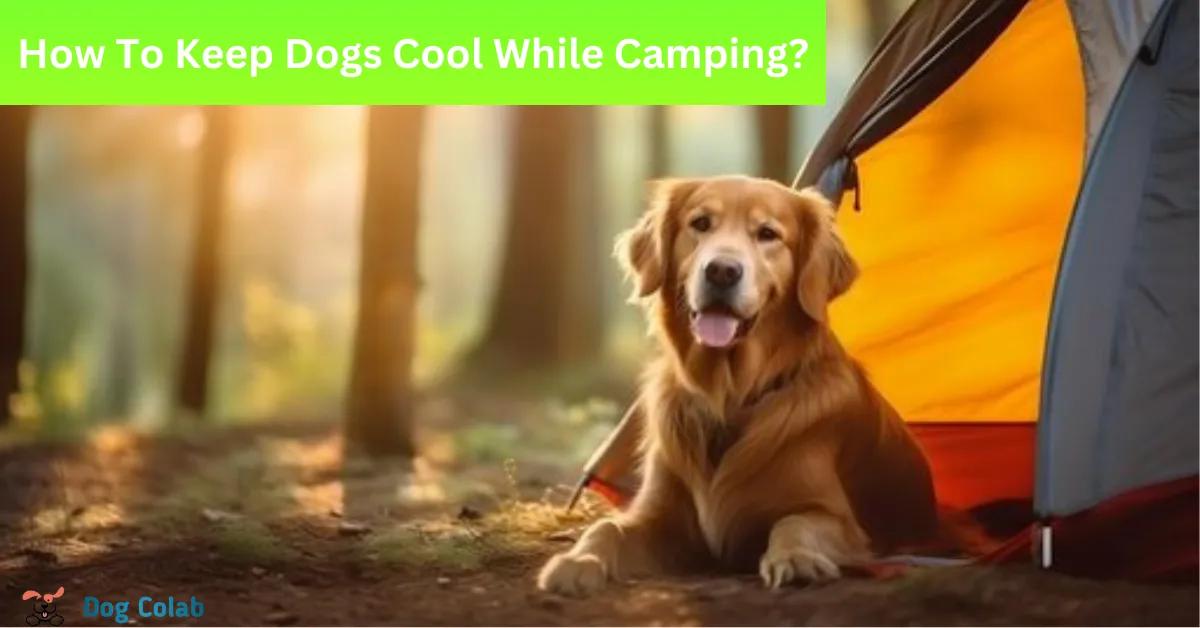A camping trip is a great way to escape from the daily grind and reconnect with nature. If you have a dog, there’s no reason to leave him behind. However, it’s crucial to ensure their comfort and well-being, especially when the temperatures rise.
When camping, provide shade and plenty of water for your dog. You can also use cooling accessories such as wet towels or portable fans to keep him cool.
In this blog post, we will discuss tips and tricks on how to keep dogs cool while camping and alternative activities for dogs during peak heat hours.
Why Keep Your Dog Cool While Camping?
Keeping your dog cool while camping is crucial to their health and well-being. Dogs are susceptible to heat-related illnesses and can’t regulate their body temperature as effectively as humans.

Here are some reasons why dogs need to keep cool while camping.
1. Heatstroke
Dogs are more prone to heatstroke due to their limited ability to cool down through sweating. Excessive heat can lead to rapid breathing, drooling, lethargy, and even collapse. Heatstroke can be fatal in severe cases.
2. Overheating
Dogs can overheat quickly, especially in hot weather or when engaging in strenuous activities like hiking. Their fur coats trap heat, making them vulnerable to high temperatures.
3. Dehydration
Dogs can become dehydrated faster than humans, and dehydration can lead to various health issues. While camping, dogs might not have access to clean water sources, so it’s essential to provide them with enough water and ensure they don’t drink from potentially contaminated sources.
4. Burned Paw Pads
Hot surfaces like asphalt and sand can burn a dog’s paw pads. When camping, paths, trails, and camping areas may become too hot for your dog to walk on comfortably.
5. Respiratory Distress
Brachycephalic breeds (dogs with short noses and flat faces) are more prone to respiratory distress in hot weather. They struggle to pant effectively, making it harder for them to cool down.
6. Sunburn
Just like humans, dogs can get sunburned, especially those with lighter fur or exposed skin. Areas with thin fur, such as the nose, ears, and belly, are particularly susceptible.
7. Heat Exhaustion
Even if it doesn’t escalate to heatstroke, prolonged exposure to high temperatures can cause heat exhaustion. This can lead to weakness, disorientation, and other symptoms that can put your dog’s safety at risk.
How To Keep Dogs Cool While Camping? (10 Ways)
It is crucial to know how to keep dogs cool on camping trip for their health and well-being, especially during hot weather. Here are some tips to help you ensure your furry friends stay comfortable and cool.
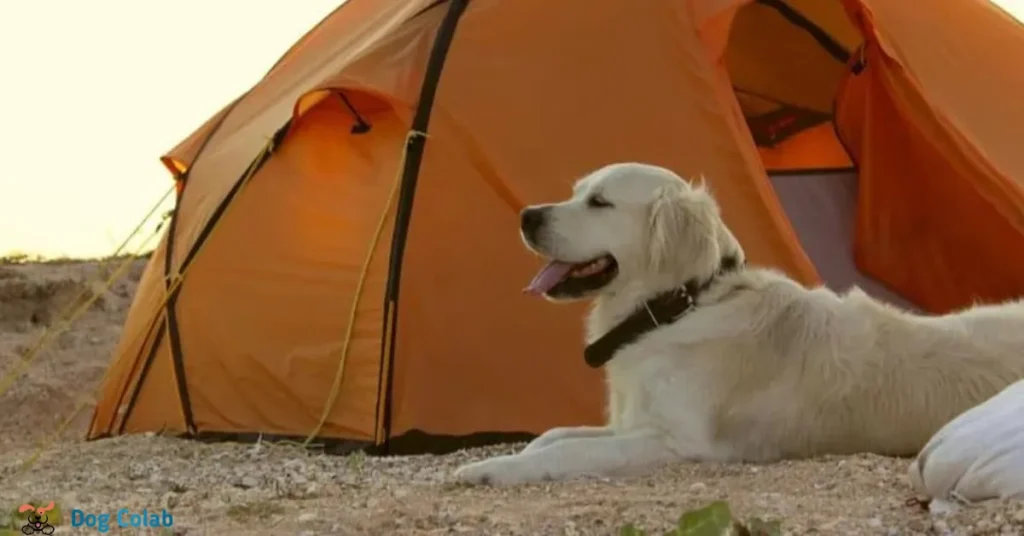
1. Choose the Right Time and Location
If possible, plan your camping trip during milder seasons when temperatures are cooler. Look for camping sites that offer shaded areas and access to water sources, like lakes or rivers.
2. Pack Sufficient Water
Just like humans, dogs need plenty of water to stay hydrated. Bring enough clean and fresh water for both you and your dogs. Collapsible water bowls are convenient for this purpose.
3. Shade
Set up your camping area in a shady spot, such as under trees or using a shade tarp. This will provide a cooler resting place for your dogs.
4. Cooling Accessories
Consider bringing cooling accessories designed for pets, like cooling mats, vests, and bandanas. These products use materials that absorb and dissipate heat, helping to keep your dogs comfortable.
5. Avoid Midday Heat
In the hottest parts of the day, usually between 10 a.m. and 4 p.m., try to limit strenuous activities. Use this time for rest in the shade.
6. Ventilation
Ensure good ventilation in your tent or camping area. This will help air circulation and prevent the space from becoming too stuffy.
7. Wet Towels or Bandanas
Dampen a towel or bandana with water and place it around your dog’s neck. Evaporative cooling can help bring down their body temperature.
8. Doggie Pool
If you’re camping near a lake or river, or have a portable doggie pool, let your dogs have a splash. Swimming can help them cool down, and many dogs enjoy the water.
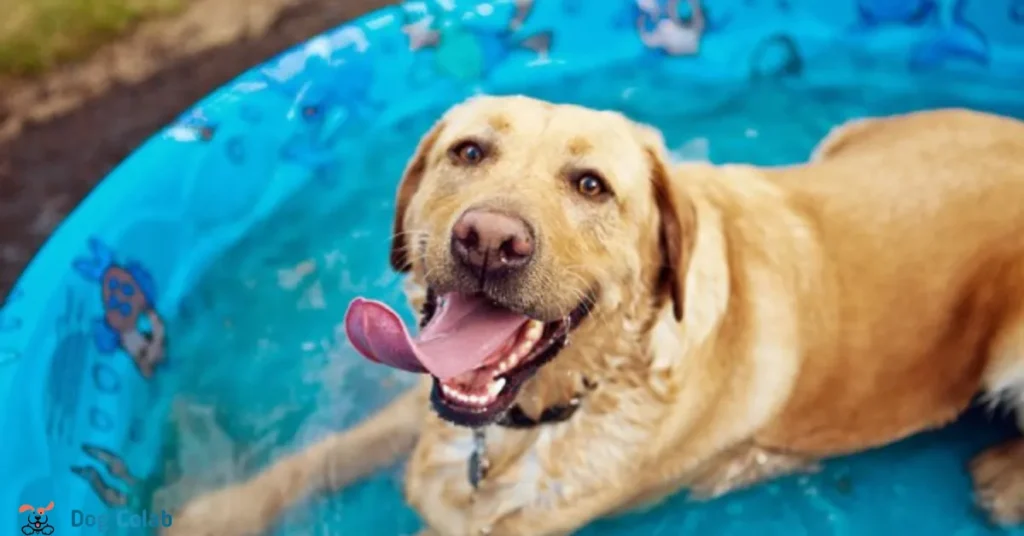
9. Proper Grooming
Keep your dog’s fur well-groomed. While it might seem counterintuitive, a dog’s coat can actually provide insulation and protection from the sun when it’s properly groomed. However, if your dog has a heavy coat and you expect extremely hot weather, you might consider a trim to help them stay cooler.
10. Stay Active During Cooler Times
You should plan your outdoor activities for the cooler mornings and evenings. This will allow you and your dogs to enjoy the outdoors without exposing them to excessive heat.
11. Avoid Hot Surfaces
Pavement, sand, and other surfaces can get extremely hot and burn your dog’s paws. Stick to grassy areas or use paw protectors if needed.
12. Watch for Signs of Overheating
Be vigilant for signs of overheating, including excessive panting, drooling, rapid heartbeat, lethargy, or vomiting. If you notice these signs, find a cool spot for your dog, offer water, and consider contacting a vet if symptoms persist.
13. Rest and Shade
Make sure your dogs have a comfortable and shady spot to rest at all times. Provide a designated resting area with soft bedding.
What Temperature Is Too Hot For Dogs Outside?
The temperature that is considered too hot for dogs outside varies depending on factors such as breed, size, age, and overall health of the dog, as well as humidity levels. However, as a general guideline, when the ambient temperature reaches around 90 degrees Fahrenheit (32 degrees Celsius) or higher, dogs are at risk of heat-related issues.
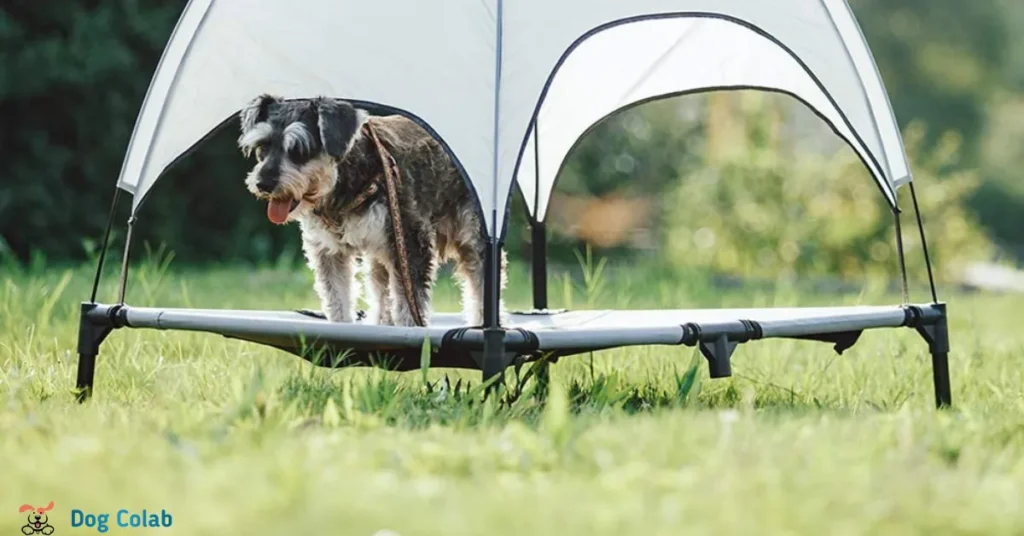
Dogs are more susceptible to heatstroke than humans due to their limited ability to cool themselves through sweating.
Read More:- Stop your dog from spilling water bowl.
How Do I Know If My Dog Is Too Hot?
It’s important to be vigilant about your dog’s well-being in hot weather. Here are some signs that your dog might be too hot.
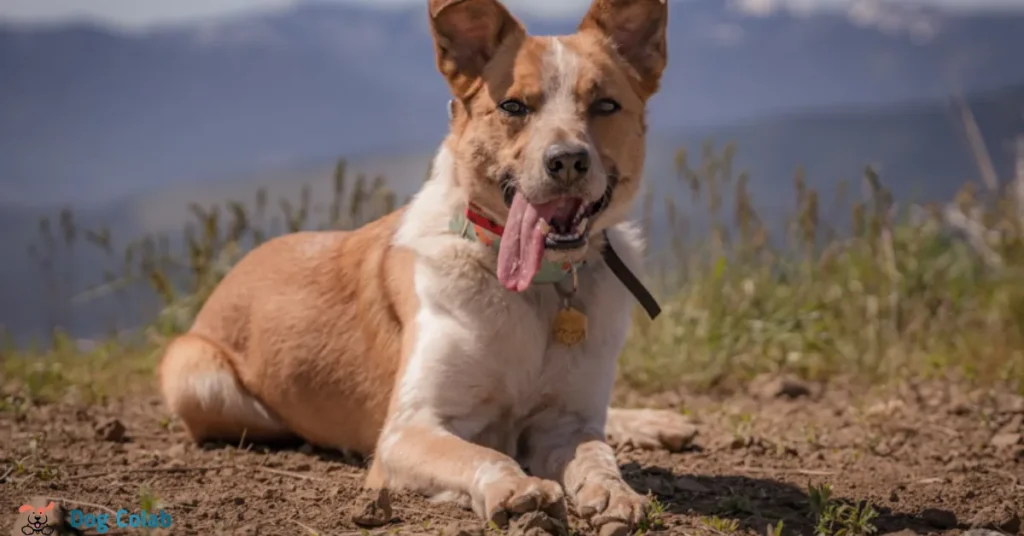
- Excessive Panting: Panting is a natural way for dogs to cool down, but excessive, rapid panting can indicate overheating.
- Excessive Drooling: Increased drooling can be a sign that your dog is struggling to regulate their body temperature.
- Lethargy: If your dog seems unusually tired, sluggish, or unwilling to move, it could be due to heat stress.
- Bright Red Gums and Tongue: An overly red or darkened tongue and gums can be a sign of heat exhaustion.
- Vomiting or Diarrhea: Digestive issues can be triggered by heat stress and can lead to dehydration.
- Loss of Coordination: If your dog is stumbling, staggering, or having trouble maintaining balance, it could be a sign of heatstroke.
- Rapid Heart Rate: An elevated heart rate, along with heavy breathing, might indicate overheating.
- Dry Nose and Gums: Dehydration can lead to dry, sticky gums and noses.
- Glazed Eyes: If your dog’s eyes appear glassy or lack their usual alertness, it could be due to heat-related stress.
- Restlessness: Anxious behavior, pacing, or trying to dig or scratch at the ground could be a sign of discomfort from heat.
Pros and Cons of Camping With Dogs In Hote Whether
Camping with dogs in hot weather can be a rewarding experience, but it also comes with certain challenges and risks. Here are some pros and cons to consider.
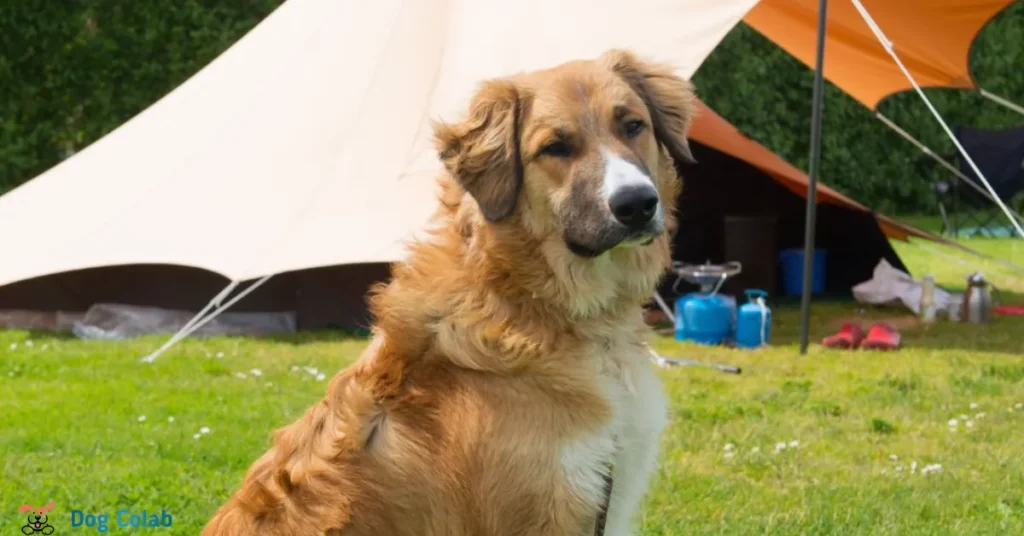
Pros
- Companionship: Camping with your dog can enhance the overall experience by providing companionship, comfort, and a sense of security.
- Exercise and Exploration: Dogs love outdoor adventures. Camping provides them with opportunities for exercise, exploration, and mental stimulation in a natural setting.
- Bonding: Camping can strengthen the bond between you and your dog through shared experiences and quality time spent together.
- Watchdog: Dogs can serve as a natural deterrent to wildlife or other potential intruders around your campsite.
- Enjoyment for Your Dog: Many dogs enjoy outdoor activities and being in nature. The sights, sounds, and scents of the outdoors can be highly stimulating and enjoyable for them.
Cons
- Heat-Related Risks: Hot weather can put dogs at risk of heat stroke, dehydration, and overheating. Heat-related issues are more prevalent in some breeds than others.
- Limited Activity Times: High temperatures often mean that outdoor activities need to be limited to cooler parts of the day, such as early morning or late afternoon.
- Paw Protection: Hot surfaces like sand and pavement can burn your dog’s paw pads. This may limit where you can take your dog and how much they can walk.
- Hydration Concerns: Dogs need access to clean, fresh water at all times, and in hot weather, they may require even more water than usual.
- Wildlife and Pests: Warm weather can bring out insects, ticks, and other pests that could bother your dog. Additionally, encounters with wildlife like snakes or insects could be a concern.
Ways To Create a Cool Camp Spot For Your Dog
Creating a cool and comfortable camp spot for your dog requires some careful planning and consideration of their needs. Here are some ways to create an enjoyable camp spot for your furry friend.
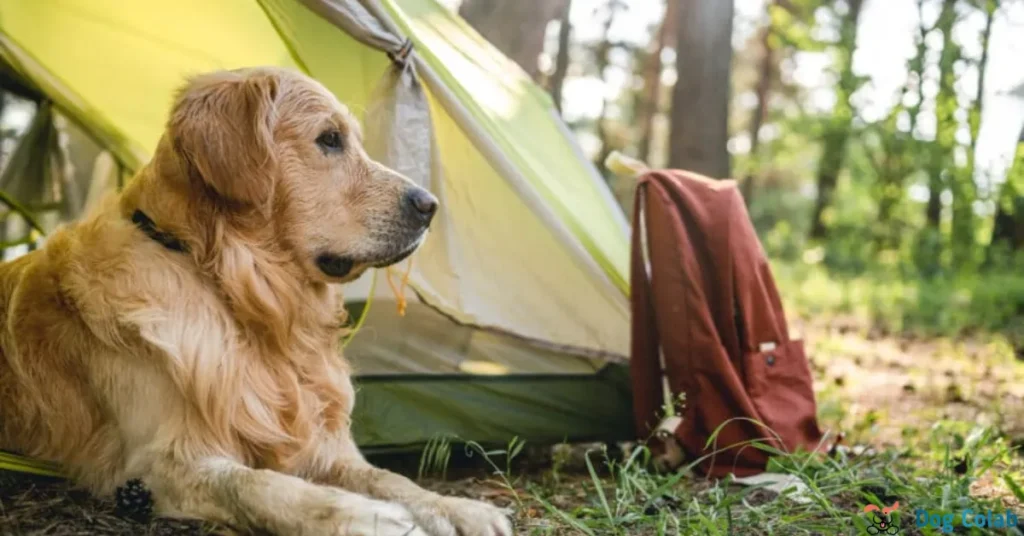
1. Choose a Shaded Area
Look for a shaded spot to set up your campsite, especially if you’re camping during hot weather. This can help keep your dog cool and save it from overheating.
2. Comfortable Bedding
Bring a comfortable and insulated dog bed or blanket for your dog to rest on. This will provide your dog with sleep and a cozy spot to relax.
3. Water and Food
Ensure a ready supply of fresh water for your dog to stay hydrated. Also, pack enough dog food and treats for the duration of the trip.
4. Tether or Leash
While allowing your dog to roam around is important, having a tether or leash on hand will help you keep them under control when necessary, especially in unfamiliar surroundings.
5. Check for Hazards
Before setting up the camp spot, inspect the area for any hazards such as sharp objects, toxic plants, or steep drops that could pose a danger to your dog.
7. Create a Cozy Space
Set up a small shaded tent or canopy where your dog can relax comfortably. This can provide them with a sense of security and a place to retreat if they feel overwhelmed.
8. Portable Fans
Using battery-powered fans is an excellent way to circulate air around your campsite and keep your dog comfortable in the heat.
Activities For Dogs During Peak Heat Hours
During peak heat hours, it’s important to keep your dog cool and prevent them from overheating. Engaging in activities that don’t require excessive physical exertion and can be done in shaded or cool areas is crucial.
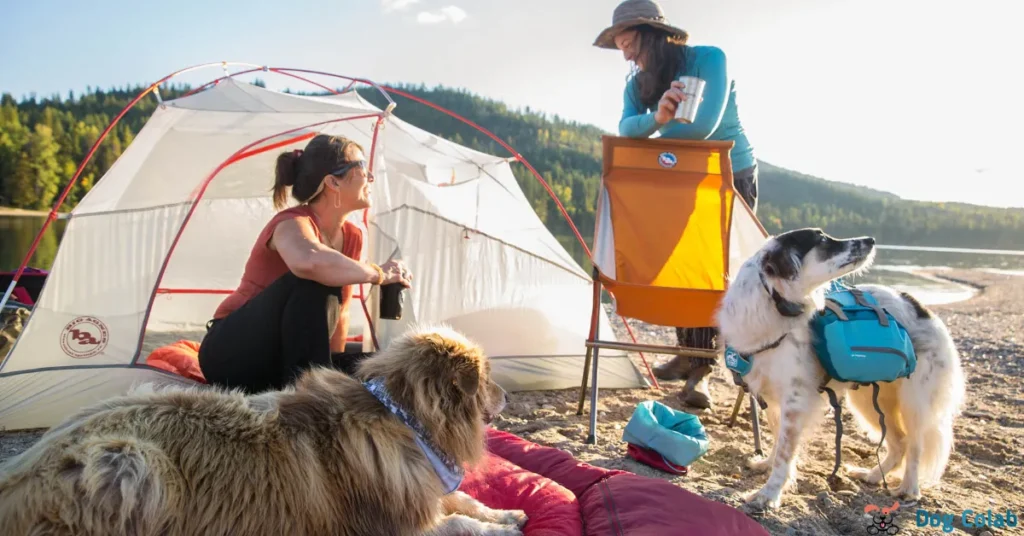
Here are some activities for dogs to enjoy during peak heat hours.
- Indoor Puzzle Toys: Engage your dog’s mind with interactive puzzle toys that dispense treats. This provides mental stimulation without requiring physical activity.
- Frozen Treats: Make dog-friendly frozen treats using ingredients like plain yogurt, peanut butter, and fruits. These treats can help cool down your dog and keep them entertained.
- Hide-and-Seek: Play a game of hide-and-seek indoors using your dog’s favorite toys or treats. This stimulates their senses and provides mental exercise.
- Training Sessions: Use the indoor time to work on training commands and tricks. Mental stimulation through training can tire out your dog without the need for intense physical activity.
- Grooming and Massage: Brushing your dog’s coat not only helps with shedding but also provides a bonding experience. Additionally, give them a gentle massage to relax their muscles.
- Water Play: If your dog enjoys water, set up a small kiddie pool or use a hose to create a gentle mist for them to play in. Constantly ensure the water is at a comfortable temperature.
- Relaxing Music or TV: Some dogs enjoy watching TV or listening to calming music. You can find videos designed specifically for dogs that might capture their attention.
- Chew Toys: Provide safe and durable chew toys that can keep your dog occupied and help clean their teeth.
Conclusion “How To Keep Dogs Cool While Camping”
Keeping your furry companion cool during camping is crucial for their well-being. Prioritize shade and hydration, providing a comfortable resting spot.
Employ cooling accessories like bandanas or vests, and opt for early morning or evening activities when temperatures are milder. Create water play opportunities and carry portable water bowls. Watch for signs of overheating, and adjust activities accordingly.
NOTE:- More information can be found by clicking this link.
FAQs
1. Can a dog overheat in a tent?
Yes, a dog can overheat in a tent, as tents can trap heat and restrict airflow. It’s important to ensure proper ventilation and monitor their comfort.
2. Will my dog get cold in a tent?
Dogs can get cold in tents, especially in cooler temperatures. Consider providing them with warm bedding or clothing to ensure their comfort and warmth.
3. How do dogs get cooler naturally?
Dogs naturally cool down through panting, which releases heat, and by dissipating heat through their paw pads. They may seek shade and water to regulate their body temperature.
4. Do dogs drink water to cool down?
Yes, dogs drink water to regulate their body temperature and stay hydrated. Panting is their primary cooling mechanism, but water helps maintain their overall temperature balance.
